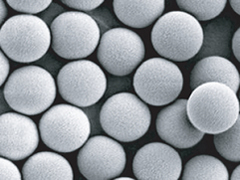
It is known that the kinetics of mass transfer in wide pore bonded silica can be slow, because of restricted intraparticle diffusion and, furthermore, remaining active surface sites can give rise to undesired interactions.
All together, these effects cause additional peak dispersion in high performance liquid chromatography and often considerable loss in recovery of biological activity [1].
Particle’s porosity elimination
A clear way around this dilemma is to eliminate the porosity, which minimizes the pore diffusion and mass transfer resistance (longitudinal diffusion) effects. The diffusion paths that analytes must traverse between stationary phase and mobile phase are very short with nonporous media and column efficiency essentially becomes independent of the flow rate [2]. Commercially available HPLC columns with nonporous stationary phases are stable at the low pH and high temperature [3].
Because of the reduction in surface area, nonporous supports exhibit much lower retention times for the same organic modifier content compared with porous columns [2]. The extremely low external surface area of nonporous supports can be regarded as a drawback since it leads to a considerably lower loadability compared with porous materials [1].
Drawbacks
Disadvantages of non-porous silica packings are that the column length is restricted because high pressure is required for an adequate mobile phase flow and it is difficult to pack a column densely and homogenously [4]. Guiochon and Martin [5] indicated that it would be almost impossible to use a high-efficiency HPLC column packed with less than 1-µm diameter particles. This suggests that the decrease in the particle diameter reaches a limit if particles are packed into columns directly.
References
- M. Hanson, K. K. Unger, LC-GC Int., (1996) 741.
- T. J. Barder, P. J. Wohlman, C. Thrall, P. D. Dubios, LC-GC Vol. 15, No.10 (1997) 918.
- R. Ohmacht, I. Kiss, Chromatographia, Vol. 42, No. 9/10 (1996) 595.
- H. Giesche, K. K. Unger, U. Esser, B. Eray, U. Truedinger, J. N. Kinkel, J.Chromatogr., 465 (1989) 39.
- G. Guiochon, M. Martin, J. Chromatogr., 326 (1985) 3.